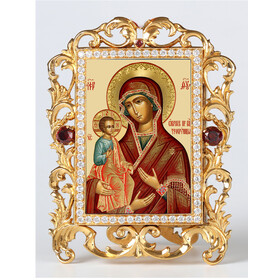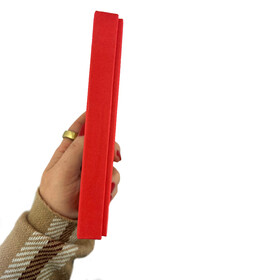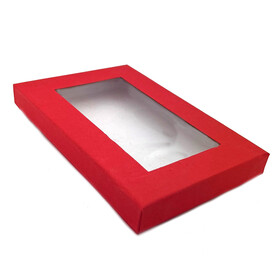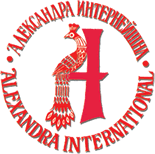Very beautiful frame
Made of metal
Faux crystals
Comes with stand for standing and 2 inch chain for hanging
Beautifully gift boxes with a transparent top - ready for gifting
Measures top to bottom 4 inch tall x 3 1/4 inch wide
Gift for any occasions on Christmas, Easter, Birthday
MOTHER OF GOD WITH “THREE HANDS“ ICON
An icon to the Russian Christian is a “window to the eternal.” The icon connects the created to his creator and His saints. The Virgin Mary is represented in over 350 different icons that have special significance to the religious life of the Russian people. While all icons play a part in the religious life of Russia, some played a part in the historical and political development of Russia.
The Church in the Eight Century was faced with a controversy concerning icons. At the time there was a lingering thought from Judaism of images and the then relatively new religion of Islam that prohibited the reproduction of the human image. This period is known as the Iconoclastic heresy. The Seventh Ecumenical Council of Nicea in 787 restored use of icons in the church.
This icon of the Virgin Mary with Three Hands is closely associated with St John of Damascus, a staunch defender of the use of icons in the Church.
A movement in the early Christian Church wanted to ban icons as graven images in violation of the First Commandment: “Thou Shall Not Make Graven Images…” St John of Damascus strongly defended the use of icons in his sermons and theological treatises. The Emperor made false accusations against St John to the Governor in Damascus to whom St John was a trusted counselor. The Governor was so outraged that he had St John’s right hand cut off with which he painted icons. St John pleaded with the Mother of God and the severed hand grew back. After this miracle St John became a monk at the Monastery of Mar (St) Sabba outside of Jerusalem to whom he gave an icon he painted of the Virgin Mary with Three Hands.
There are two traditions on the origin of the “third” hand on the icon. One tradition holds St John had a hand made out of silver that he attached to the icon. This is the origin of the tradition of attaching silver body parts to icons in Greece in either petition for or to give thanks for a healing. This tradition is also the origin of the Spanish Migros. The other tradition is he wrote (painted) the icon with a third hand.
St John wrote many hymns and services used in the Eastern Church. It is said he wrote on of the most famous hymns of the Church to this icon: “In thee rejoices all creation. Thou full of grace…”
The icon was given by the Monastery of Mar Sabba to St Sabba of Serbia in the 1200s and remained there until Serbia was invaded by the Turks when the icon was taken to the Holy Mount Athos Serbian Monastery of Hilander. The icon is often referred to as the Hilander Icon. The icon is credited with protecting the Holy Mountain.
A copy of the Wonder working icon was brought to Moscow in 1661. Copies of the icon were made and widely distributed through out Russia. The icon brought to Russia in 1661 is now in the Holy Dormition Church of the Bulgarian Metochian in Moscow.
The letters “MP” and “O (Phi) Y” on either side is the Greek abbreviation for Mary as the “Mother of God.” The “stars” on her head and shoulders represent Mary’s virginity.
Copyright: Alexandra International 2024






